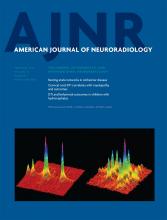Article CommentaryNeurointervention
Open Access
Effect of Bifurcation Angle Configuration and Ratio of Daughter Diameters on Hemodynamics of Bifurcation Aneurysms
A. Farnoush, A. Avolio and Y. Qian
American Journal of Neuroradiology February 2013, 34 (2) 391-396; DOI: https://doi.org/10.3174/ajnr.A3222
A. Farnoush
aFrom the Australian School of Advanced Medicine, Macquarie University, Sydney, Australia.
A. Avolio
aFrom the Australian School of Advanced Medicine, Macquarie University, Sydney, Australia.
Y. Qian
aFrom the Australian School of Advanced Medicine, Macquarie University, Sydney, Australia.

References
- 1.↵
- Steinman DA,
- Milner JS,
- Norley CJ,
- et al
- 2.↵
- Hassan T,
- Timofeev EV,
- Ezura M,
- et al
- 3.↵
- Jou L-D,
- Quick CM,
- Young WL,
- et al
- 4.↵
- Castro M
- 5.↵
- Ma B,
- Harbaugh RE,
- Raghavan ML
- 6.↵
- Raghavan ML,
- Ma B,
- Harbaugh RE
- 7.↵
- 8.↵
- Hassan T,
- Timofeev EV,
- Saito T,
- et al
- 9.↵
- 10.↵
- 11.↵
- Shojima M,
- Oshima M,
- Takagi K,
- et al
- 12.↵
- Qian Y,
- Takao H,
- Umezu M,
- et al
- 13.↵
- Cebral JR,
- Mut F,
- Weir J,
- et al
- 14.↵
- Jou LD,
- Lee DH,
- Morsi H,
- et al
- 15.↵
- Xiang J,
- Natarajan SK,
- Tremmel M,
- et al
- 16.↵
- Ujiie H,
- Sato K,
- Ondo H,
- et al
- 17.↵
- 18.↵
- Umansky F,
- Juarez SM,
- Dujovny M,
- et al
- 19.↵
Unruptured intracranial aneurysms–risk of rupture and risks of surgical intervention. N Engl J Med 1998;339:1725
- 20.↵
- 21.↵
- 22.↵
- 23.↵
- Ford MD,
- Alperin N,
- Lee SH,
- et al
- 24.↵
- Hoi Y,
- Meng H,
- Woodward SH,
- et al
- 25.↵
- Karmonik C,
- Klucznik R,
- Benndorf G
- 26.↵
- Cebral JR,
- Castro MA,
- Appanaboyina S,
- et al
- 27.↵
- 28.↵
- Tremmel M,
- Dhar S,
- Levy EI,
- et al
- 29.↵
- Cebral J,
- Sheridan M
In this issue
Advertisement
A. Farnoush, A. Avolio, Y. Qian
Effect of Bifurcation Angle Configuration and Ratio of Daughter Diameters on Hemodynamics of Bifurcation Aneurysms
American Journal of Neuroradiology Feb 2013, 34 (2) 391-396; DOI: 10.3174/ajnr.A3222
0 Responses
Jump to section
Related Articles
- No related articles found.
Cited By...
This article has been cited by the following articles in journals that are participating in Crossref Cited-by Linking.
- Khalid M Saqr, Sherif Rashad, Simon Tupin, Kuniyasu Niizuma, Tamer Hassan, Teiji Tominaga, Makoto OhtaJournal of Cerebral Blood Flow & Metabolism 2020 40 5
- Weimin Zhang, Jinlong Liu, Qin Yan, Jinfen Liu, Haifa Hong, Le MaoInteractive CardioVascular and Thoracic Surgery 2016 23 4
- Nimmy Thankom Philip, Srinivas Bolem, B.J. Sudhir, B.S.V. PatnaikComputer Methods and Programs in Biomedicine 2022 227
- Nimer Adeeb, Christoph J Griessenauer, Apar S Patel, Paul M Foreman, Carlos E Baccin, Justin M Moore, Raghav Gupta, Abdulrahman Alturki, Mark R Harrigan, Christopher S Ogilvy, Ajith J ThomasNeurosurgery 2018 82 5
- Qingyuan Liu, Pengjun Jiang, Jun Wu, Bin Gao, Shuo WangFrontiers in Neuroscience 2019 13
- Azadeh Farnoush, Alberto Avolio, Yi QianJournal of Clinical Neuroscience 2014 21 9
- A.P. Narata, F.S. de Moura, I. Larrabide, C.M. Perrault, F. Patat, R. Bibi, S. Velasco, A.-C. Januel, C. Cognard, R. Chapot, A. Bouakaz, C.A. Sennoga, A. MarzoAmerican Journal of Neuroradiology 2018 39 2
- Z. Huang, M. Zeng, W.G. Tao, F.Y. Zeng, C.Q. Chen, L.B. Zhang, F.H. ChenAmerican Journal of Neuroradiology 2020 41 7
- Marie-Sophie Schüngel, Karl-Titus Hoffmann, Erik Weber, Jens Maybaum, Nikolaos Bailis, Maximilian Scheer, Ulf Nestler, Stefan SchobJournal of Clinical Medicine 2023 12 7
- Yujie Li, Yuuya Yoneyama, Haruo Isoda, Masaki Terada, Takafumi Kosugi, Takashi Kosugi, Mingzi Zhang, Makoto OhtaTechnology and Health Care 2021 29 2
More in this TOC Section
Similar Articles
Advertisement











